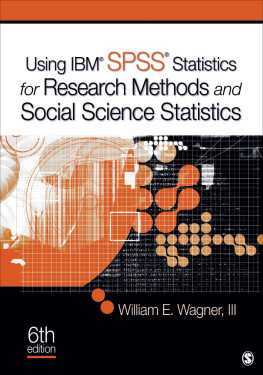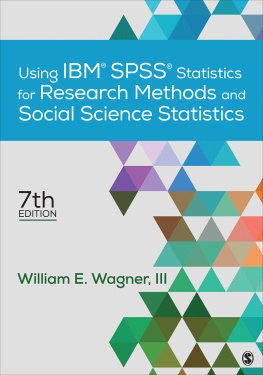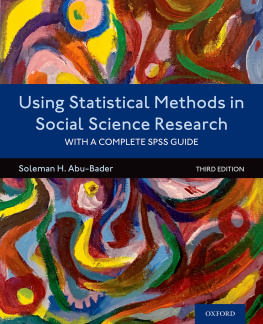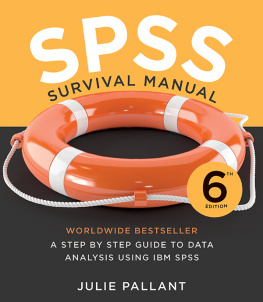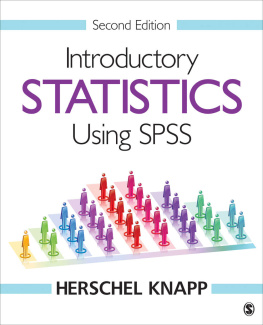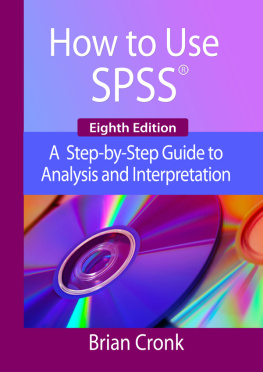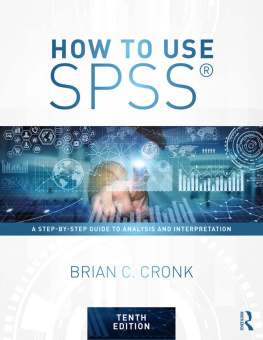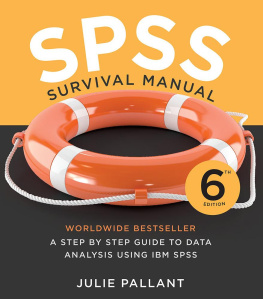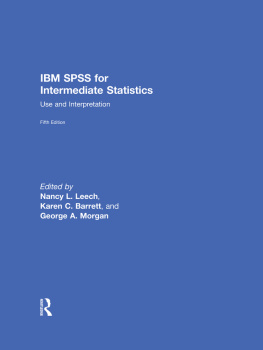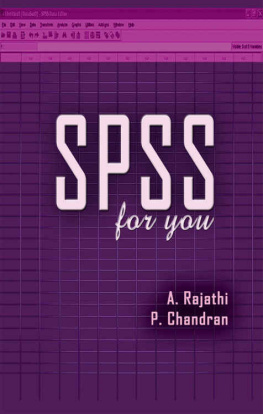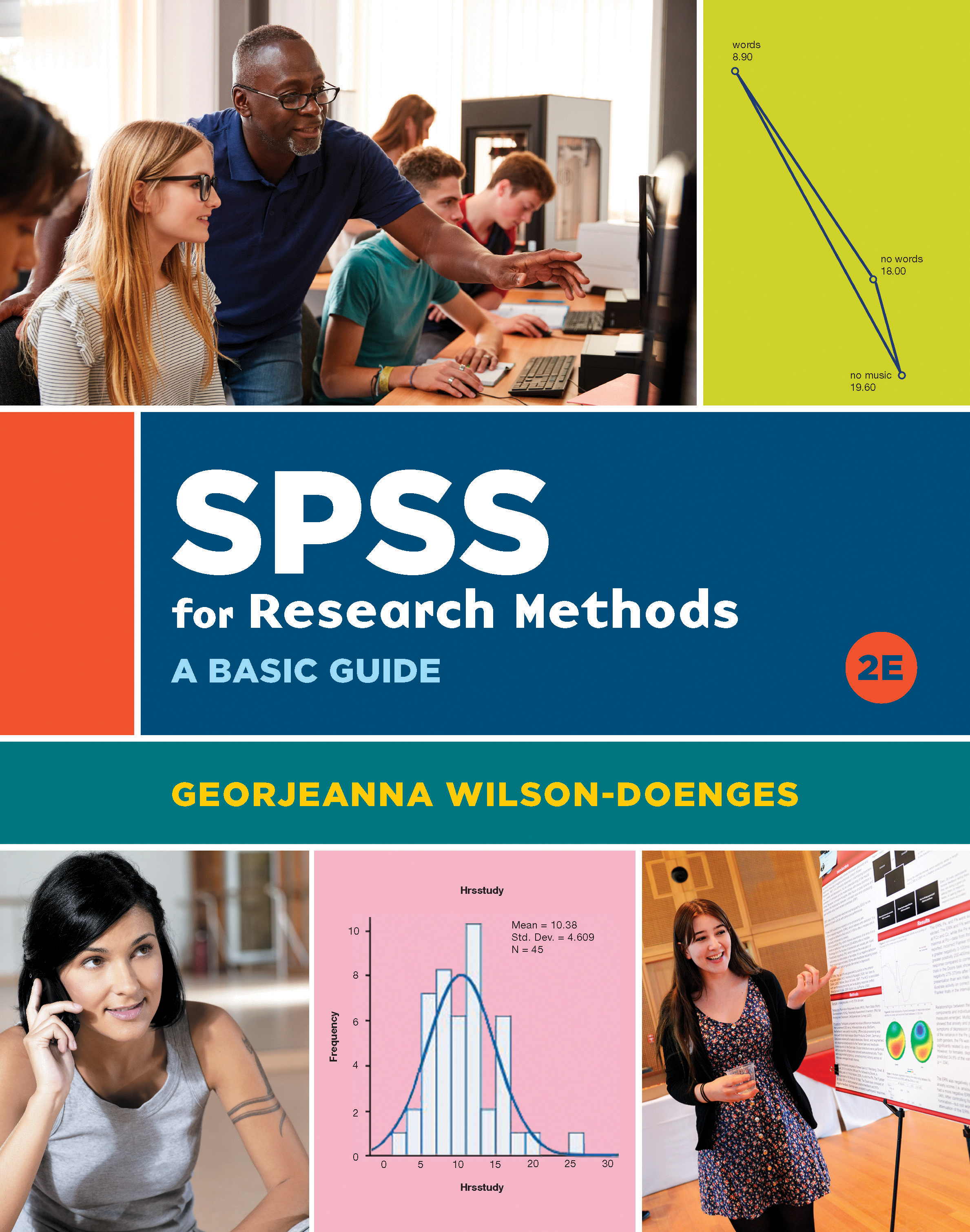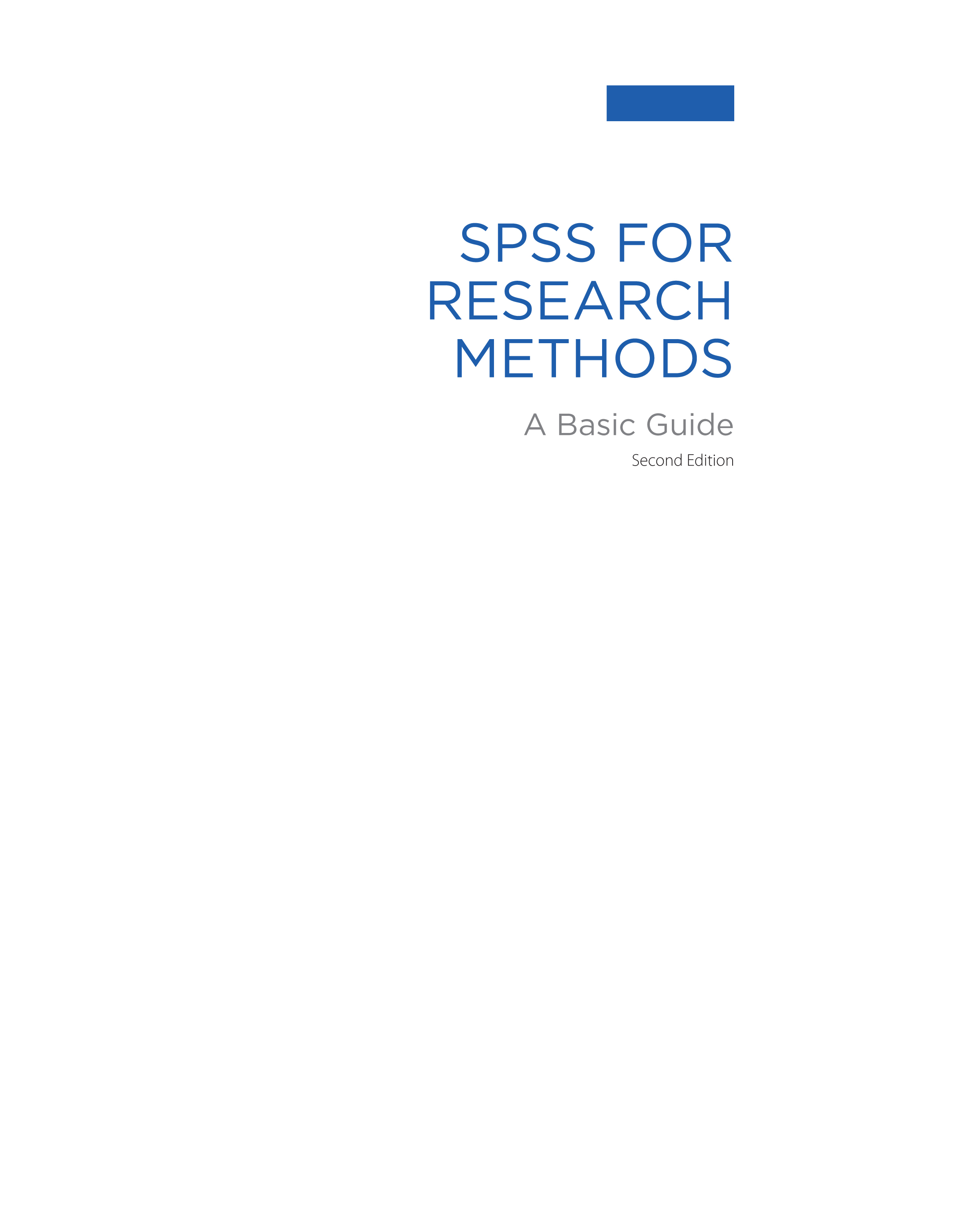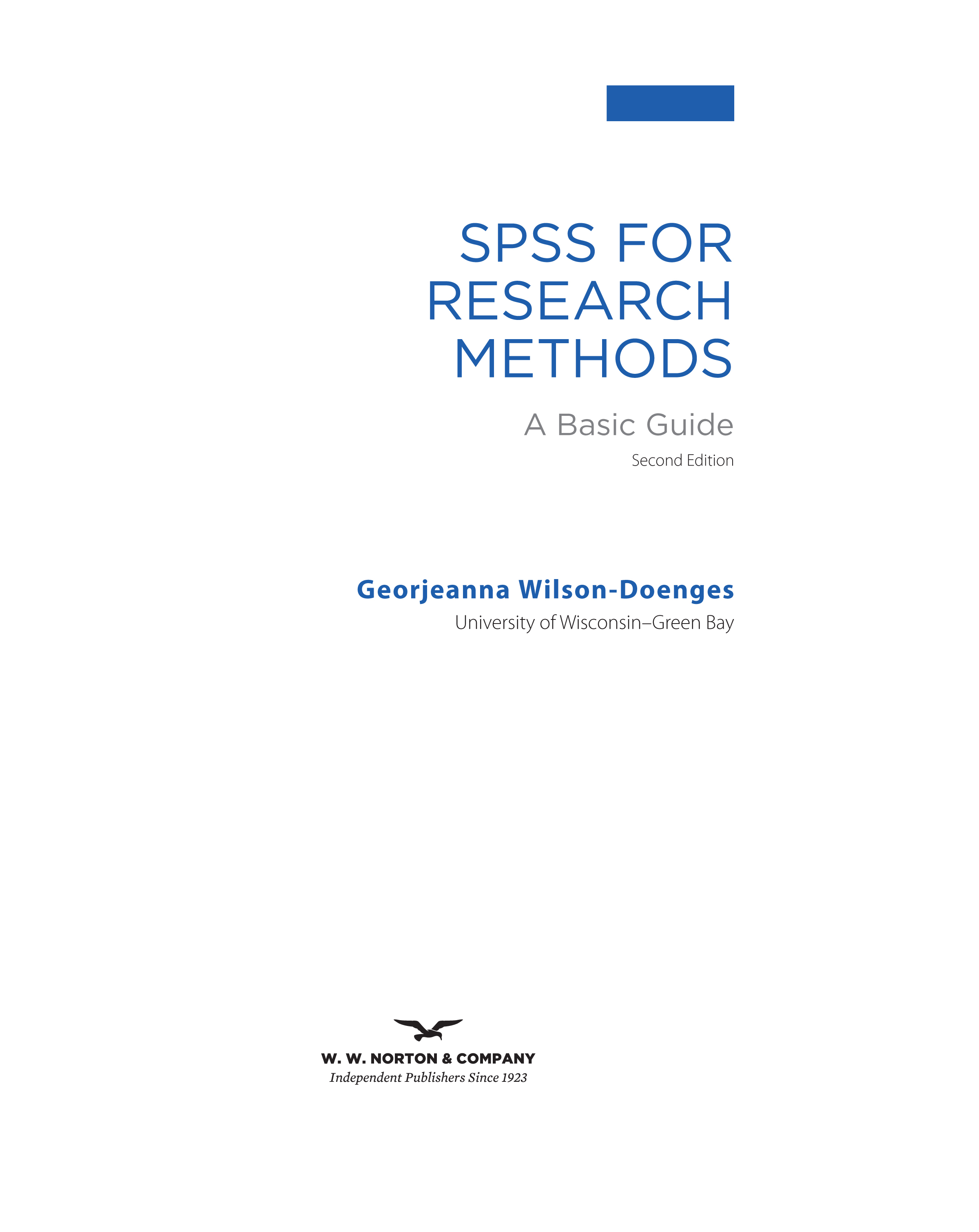Publishers Notice
Please note that this version of the ebook does not include access to any media or print supplements that are sold packaged with the printed book.
W. W. Norton & Company has been independent since its founding in 1923, when William Warder Norton and Mary D. Herter Norton first published lectures delivered at the Peoples Institute, the adult education division of New York Citys Cooper Union. The firm soon expanded its program beyond the Institute, publishing books by celebrated academics from America and abroad. By midcentury, the two major pillars of Nortons publishing programtrade books and college textswere firmly established. In the 1950s, the Norton family transferred control of the company to its employees, and todaywith a staff of five hundred and hundreds of trade, college, and professional titles published each yearW. W. Norton & Company stands as the largest and oldest publishing house owned wholly by its employees.
IBM SPSS Statistics software (SPSS) reprints courtesy of International Business Machines Corporation, International Business Machines Corporation. IBM, the IBM logo, ibm.com, and SPSS are trademarks or registered trademarks of International Business Machines Corporation, registered in many jurisdictions worldwide. Other product and service names might be trademarks of IBM or other companies. A current list of IBM trademarks is available on the Web at IBM Copyright and trademark information at www.ibm.com/legal/copytrade.shtml.
Copyright 2021, 2015 by W. W. Norton
All rights reserved
Editors: Chloe Weiss and Sheri Snavely
Project Editor: Taylere Peterson
Production Manager: Jane Searle
Managing Editor, College: Marian Johnson
Managing Editor, College Digital Media: Kim Yi
Media Editor: Kaitlin Coats
Associate Media Editor: Christina Fuery
Media Project Editors: Danielle Belfiore and Diane Cipollone
Media Editorial Assistant: Emilia Pesantes
Ebook Production Manager: Sophia Purut
Marketing Research and Strategy Manager: Casey Johnson
Design Director: Rubina Yeh
Designers: Deborah Dutton & Juan Paolo Francisco
Director of College Permissions: Megan Schindel
Permissions Manager: Bethany Salminen
Permissions Specialist: Joshua Garvin
Photo Editor: Stephanie Romeo
Composition: KnowledgeWorks Global Ltd
Illustrations: KnowledgeWorks Global Ltd
Permission to use copyrighted material is included in the Credits on .
Cover photographs: (top) monkeybusinessimages/iStock Photo. (bottom left) BEW Authors/Agefotostock. (bottom right) Courtesy of Wesleyan University.
Library of Congress Cataloging-in-Publication Data
Names: Wilson-Doenges, Georjeanna, author.
Title: SPSS for research methods : a basic guide / Georjeanna Wilson-Doenges, University of WisconsinGreen Bay.
Description: Second edition. | New York, NY : W.W. Norton & Company, [2022] | Includes bibliographical references and index.
Identifiers: LCCN 2021029507 | ISBN 9780393543063 (spiral bound) | ISBN 9780393884791 (epub)
Subjects: LCSH: SPSS for Windows. | Social sciencesResearchMethodology. | Social sciencesStatistical methodsComputer programs.
Classification: LCC HA32 .W55 2022 | DDC 005.5/5dc23
LC record available at https://lccn.loc.gov/2021029507
ISBN: 978-0-393-54306-3 (pbk.)
ISBN: 978-0-393-88479-1 (ebk.)
W. W. Norton & Company, Inc., 500 Fifth Avenue, New York, NY 10110
wwnorton.com
W. W. Norton & Company Ltd., 15 Carlisle Street, London W1D 3BS
Ebook version: 2.1-retailer
For my father, my inspiration
About the Author
Georjeanna Wilson-Doenges is Chair and Professor of Psychology at the University of WisconsinGreen Bay. She received her Ph.D. from the University of CaliforniaIrvine. Her research interests involve individuals interpretation of sense of community, student engagement in college, experiential learning, and assessment of undergraduate psychology learning outcomes. She has taught research methods and statistics courses with an SPSS lab component for over 25 years. Year after year, she has refined her teaching to help students who are often fearful of data analysis by making her courses engaging and promoting success in even the most math-insecure students. Throughout her career, Dr. Wilson-Doenges has emphasized teaching and writing about data analysis in clear and accessible ways.
Brief Contents
Preface
Data analysis plays a crucial role in the science of psychology. The most innovative research can be flawed by improper handling of data, while the skillful reading of results can shed new light in surprising places. To succeed in statistics and research methods coursesand to prepare themselves for whatever research they take onstudents must develop strong data analytic skills. As SPSS is one of the most commonly used software packages for data analysis in the social sciences, I wrote this guide to help students with little or no experience to quickly and independently familiarize themselves with the program basics.
Instructors often say that they prefer to focus their lectures on the content of statistics and research methods without getting bogged down in the computer skills required for data analysis. Over 25 years of teaching these courses, I have seen that covering the essentials of SPSS takes up valuable class time that would often be better spent illustrating key concepts with real-world, research-based examples. In addition, students most effectively learn the operation of SPSS by using it, hands-on, but it is difficult to teach one-on-one when there are usually at least 25 students per class.
This guide fosters SPSS skill development outside the classroom. It is easy to read and enables students to build their knowledge of the software at their own pace. The examples in each chapter walk students through all the aspects of data analysis by including the research question, a brief description of the method, the data entered, the SPSS commands relevant to the research question, the SPSS output, an interpretation of the output, and the corresponding results section written in APA style. Each step is clearly indicated by a banner in the margins, and screen shots ensure that the instructions in the text are as clear as possible. I believe that instructors will have the freedom to spend more of their class time presenting engaging content, knowing that their students have this guide to help them along the way.
Another major challenge to teaching data analysis is that students are often anxious about learning statistics and using SPSS. This guide aims to dispel those fears. Jargon-heavy, dense paragraphs, and abstract presentations of concepts can leave students feeling more than a little confused, so I consistently stayed with succinct, step-by-step explanations. The examples, which stem from topics my own students have been excited to testlike relationships between having a tattoo and perceived intelligence, or motivation and GPAshould feel familiar and compelling. The screen shots are overlaid with arrows that point to the functions necessary for each step of data analysis. Thanks to these features, students will learn to efficiently complete rigorous statistical analyses.


